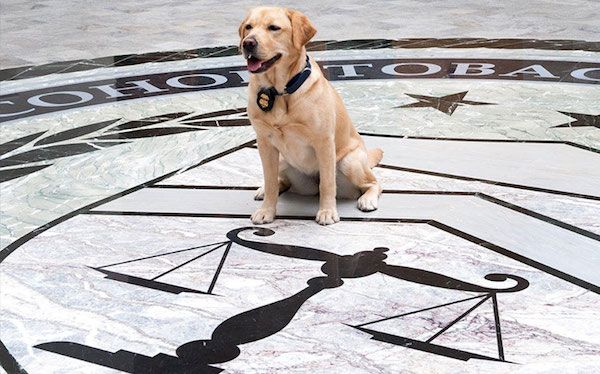
The trademark of the U.S. Treasury Department’s Bureau of Alcohol, Tobacco, and Firearms canine program is the exclusive use of Labrador Retrievers. The ATF acquires its dogs from various guide dog foundations like Puppies Behind Bars, dogs who are often “dropouts” because their excess energy makes them a poor fit for service dogs, and trains them.
While other breeds may possess the temperament and qualities for explosive detection, ATF only uses Labs because it has found that they are a hearty, intelligent breed readily adaptable to changing environments. A gentle disposition allows several teams to work near each other, and for teams to work in crowds and around kids. Put another way, very few people consider screening activities by a Labrador Retriever handled by a uniformed officer to be threatening or intrusive.
The first dog trained by the ATF to sniff out firearms and explosives was a black Lab named “Charlie.” Charlie sniffed out more than 200 illegal guns and 500 pounds of hidden explosives, which at the time easily outperformed electronic sensors. Charlie helped solve a terrorist bombing case by discovering just a minute fragment of the bomb that had landed hundreds of yards away from the site of the explosion. Evidently, one can take vacation day with a bomb detection dog, but one can’t take bomb detection out of the dog. While on a recreational visit to a US. Civil War battlefield, Charlie smelled out cannonball fragments that had been buried for 130 years!
ATF’s canine training facility is located in rural Virginia with the U.S. Customs and Border Protection facility.
Since 1990, ATF has trained approximately 919 explosives detection canines and 253 accelerant detection canines. A dog who graduates only after successfully completing a ten week explosive detection training program emerges as a canine conditioned to detect explosives, explosives residue, and post blast evidence. Because of their conditioning to smokeless powder and other explosive fillers, ATF trained explosives detection dogs can also detect firearms and ammunition hidden in containers and vehicles, on persons and buried underground. The dogs must pass annual certifications that have been independently validated by Oak Ridge National Laboratories. The ATF is reimbursed by the State Department’s Antiterrorism Assistance Program for all costs associated with training foreign countries. U.S. agencies receive their canines and training at no charge in exchange for assisting ATF when needed.
Auburn University in Alabama has also operated a Canine Detection Training Center for over 25 years, and a number of federal, state and local agencies (such as Customs and Border Protection, the Metropolitan Atlanta Rapid Transit Authority, and the Department of Defense) have their dogs trained there because of the range of training services it offers. Recently, Vapor Wake® detection technology was addd to those services. As of 2005, Auburn had produced 21 litters of Labrador Retriever Puppies from which more than 50 successfully trained detector dogs were paired with law enforcement handlers.
Watch one of the Auburn trained dogs at work in the video below:
Click here to see a gallery of ATF canines.
Image shared with consent from the AKC from the 2016 article, “Federal Bomb-Sniffing Dogs Trained To Find Homemade Explosives.”

